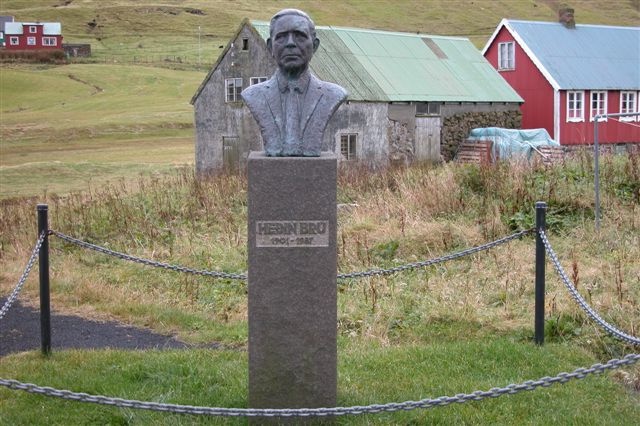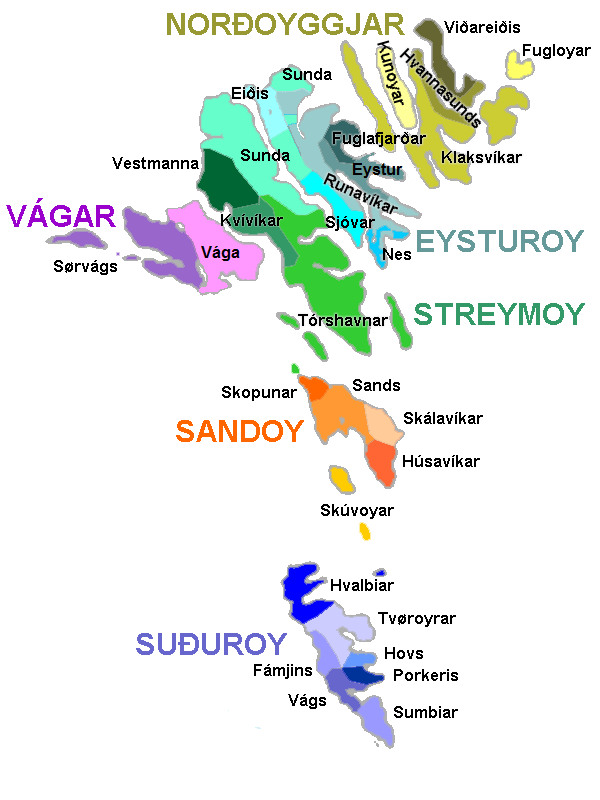|
Skálavík
Skálavík ( da, Skålevig) is a village and municipality on the eastern coast of the Faroese island Sandoy. History The village's stone church was built in 1891. The famous Faroese writers Heðin Brú (born Hans Jacob Jacobsen) (1901–1987) and Kristian Osvald Viderø (1906–1988) were both born in Skálavík. In late January 2008 Skálavík was hit by a strong hurricane. The port was destroyed, along with many boats and houses. The damage was so great that emergency aid was provided from Iceland. Depilin í Skálavík - Hotel Skálavík In May 2011 a new center opened in Skálavík. It was donated by shipowner Eiler Jacobsen (1930-2010), who was born in the village. He did not live to see the opening, but he visited the building during the construction. There is a restaurant, a hotel and conference center, activities for children etc. The center was named Skeiðs- og frítíðardepilin Immanuel, but they also use the name "Depilin í Skálavík" (The Center in Skálavík). I ... [...More Info...] [...Related Items...] OR: [Wikipedia] [Google] [Baidu] |
Kristian Osvald Viderø
Kristian Osvald Viderø (27 May 1906, in Skálavík – 8 April 1991, in Copenhagen) was a Faroese clergyman, poet and Bible translator. In 1985 he won the Faroese Literature Prize for his works. Biography After theological studies in Denmark, Viderø oversaw the completion of a translation of the Old Testament into the Faroese language Faroese ( ; ''føroyskt mál'' ) is a North Germanic language spoken as a first language by about 72,000 Faroe Islanders, around 53,000 of whom reside on the Faroe Islands and 23,000 in other areas, mainly Denmark. It is one of five languages des ..., which Jákup Dahl had worked on until his death in 1944. He was the parish priest of Hattarvík from 1965 to 1969. Viderø was commemorated on a Faroese postage stamp in a series on Faroese Bible translators in June 2007. Bibliography * Ferð mín til Jorsala. Tórshavn: E. Thomsen, 1984. * Á Suðurlandið. Tórshavn: E. Thomsen, 1990. * Ferð mín til Jorsala á himni. Tórshavn:: E. Tho ... [...More Info...] [...Related Items...] OR: [Wikipedia] [Google] [Baidu] |
Heðin Brú
Heðin Brú (pronounced ; August 17, 1901, Skálavík – May 18, 1987, Tórshavn) was the pen-name of Hans Jacob Jacobsen, a Faroese novelist and translator. Heðin Brú is considered to be the most important Faroese writer of his generation and is known for his fresh and ironic style. His novel, ''Feðgar á ferð'' (''The Old Man and His Sons''), was chosen as the ''Book of the twentieth century'' by the Faroese. Life and Works Like many of his countrymen, Jacobsen worked as a fisherman in his early years. After two seasons, he left to study agriculture in Denmark. When he returned to the Faroes, he worked as an agricultural advisor—a job that took him to all parts of the country. The contacts he made with ordinary village people he met during this time had a lasting effect on his writing. In 1930, his first novel, ''Lognbrá'', which tells the story of a young man growing up in a Faroese village, was published. In 1935 there appeared its sequel, ''Fastatøkur'' ... [...More Info...] [...Related Items...] OR: [Wikipedia] [Google] [Baidu] |
Sandoy
Sandoy ("Sand Island") is the first of the five southern islands that make up the Faroe chain, the fifth biggest of all the Faroe Islands, an autonomous region of the Kingdom of Denmark. It also refers to the region that includes this island along with Skúvoy and Stóra Dímun. , the largest population centre on the island is the village of Sandur with a population of 532. Other settlements include Skarvanes, Skopun, Skálavík, Húsavík and Dalur. Sandoy gets its name from the large beach at Sandur, and the general sandy soil of the island. It is the only island with dunes. There are similarly named islands, Sanday in the Orkney Islands, Sanday in the Inner Hebrides and Sandøy in Norway. At present the Sandoyartunnilin is being constructed between the centre of the island and the port of Gamlarætt on Streymoy. Construction started in 2019 and is not expected to be finished before 2023. Agriculture The island is considered the best island for agriculture due to ... [...More Info...] [...Related Items...] OR: [Wikipedia] [Google] [Baidu] |
List Of Towns In The Faroe Islands ...
This is a list of villages (and towns) of the Faroe Islands. :fo:Býir í Føroyum :de:Liste der Städte und Orte auf den Färöern References {{DEFAULTSORT:List Of Towns In The Faroe Islands Towns Faroe Islands The Faroe Islands ( ), or simply the Faroes ( fo, Føroyar ; da, Færøerne ), are a North Atlantic archipelago, island group and an autonomous territory of the Danish Realm, Kingdom of Denmark. They are located north-northwest of Scotlan ... [...More Info...] [...Related Items...] OR: [Wikipedia] [Google] [Baidu] |
Municipalities Of The Faroe Islands
The Faroe Islands are administratively divided in 29 municipalities (''kommunur''), with about 120 cities and villages. Until December 31, 2008, there were 34 municipalities, and until December 31, 2004, there were 48 municipalities. In the coming years the number of Faroese municipalities is expected to drop to somewhere between 7 and 15, as there is currently a rationale towards municipal amalgamation and a decentralization of public services. In 1998 it was suggested that no municipality should have fewer than 2,000 inhabitants, but whether this will be true is a political question. The Faroese government has furthermore decided not to conduct forced, top-down amalgamation, but to leave the process to the free will of the municipalities. In many small municipalities there is some resistance to the amalgamation process, and as a result two kinds of municipalities are being created: large municipalities (town-municipalities) that are eager to attract smaller municipalities into ama ... [...More Info...] [...Related Items...] OR: [Wikipedia] [Google] [Baidu] |
Greenwich Mean Time
Greenwich Mean Time (GMT) is the mean solar time at the Royal Observatory in Greenwich, London, counted from midnight. At different times in the past, it has been calculated in different ways, including being calculated from noon; as a consequence, it cannot be used to specify a particular time unless a context is given. The term 'GMT' is also used as one of the names for the time zone UTC+00:00 and, in UK law, is the basis for civil time in the United Kingdom. English speakers often use GMT as a synonym for Coordinated Universal Time (UTC). For navigation, it is considered equivalent to UT1 (the modern form of mean solar time at 0° longitude); but this meaning can differ from UTC by up to 0.9s. The term GMT should thus not be used for purposes that require precision. Because of Earth's uneven angular velocity in its elliptical orbit and its axial tilt, noon (12:00:00) GMT is rarely the exact moment the Sun crosses the Greenwich Meridian and reaches its highest po ... [...More Info...] [...Related Items...] OR: [Wikipedia] [Google] [Baidu] |
Western European Summer Time
Western European Summer Time (WEST, UTC+01:00) is a summer daylight saving time scheme, 1 hour ahead of Greenwich Mean Time and Coordinated Universal Time. It is used in: * the Canary Islands * Portugal (including Madeira but not the Azores) * the Faroe Islands The following countries also use the same time zone for their daylight saving time but use a different title: *United Kingdom, which uses British Summer Time (BST) *Ireland, which uses Irish Standard Time (IST) ( (ACÉ)). Also sometimes erroneously referred to as "Irish Summer Time" (). The scheme runs from the last Sunday in March to the last Sunday in October each year. At both the start and end of the schemes, clock changes take place at 01:00 UTC+00:00. During the winter, Western European Time (WET, GMT+0 or UTC±00:00) is used. The start and end dates of the scheme are asymmetrical in terms of daylight hours: the vernal time of year with a similar amount of daylight to late October is mid-February, well before t ... [...More Info...] [...Related Items...] OR: [Wikipedia] [Google] [Baidu] |
Köppen Climate Classification
The Köppen climate classification is one of the most widely used climate classification systems. It was first published by German-Russian climatologist Wladimir Köppen (1846–1940) in 1884, with several later modifications by Köppen, notably in 1918 and 1936. Later, the climatologist Rudolf Geiger (1894–1981) introduced some changes to the classification system, which is thus sometimes called the Köppen–Geiger climate classification system. The Köppen climate classification divides climates into five main climate groups, with each group being divided based on seasonal precipitation and temperature patterns. The five main groups are ''A'' (tropical), ''B'' (arid), ''C'' (temperate), ''D'' (continental), and ''E'' (polar). Each group and subgroup is represented by a letter. All climates are assigned a main group (the first letter). All climates except for those in the ''E'' group are assigned a seasonal precipitation subgroup (the second letter). For example, ''Af'' i ... [...More Info...] [...Related Items...] OR: [Wikipedia] [Google] [Baidu] |
Oceanic Climate
An oceanic climate, also known as a marine climate, is the humid temperate climate sub-type in Köppen classification ''Cfb'', typical of west coasts in higher middle latitudes of continents, generally featuring cool summers and mild winters (for their latitude), with a relatively narrow annual temperature range and few extremes of temperature. Oceanic climates can be found in both hemispheres generally between 45 and 63 latitude, most notably in northwestern Europe, northwestern America, as well as New Zealand. Precipitation Locations with oceanic climates tend to feature frequent cloudy conditions with precipitation, low hanging clouds, and frequent fronts and storms. Thunderstorms are normally few, since strong daytime heating and hot and cold air masses meet infrequently in the region. In most areas with an oceanic climate, precipitation comes in the form of rain for the majority of the year. However, some areas with this climate see some snowfall annually during winter. ... [...More Info...] [...Related Items...] OR: [Wikipedia] [Google] [Baidu] |
Smyril Line
Smyril Line is a Faroese shipping company, linking the Faroe Islands with Denmark and Iceland. It previously also served Norway and the United Kingdom. is the Faroese word for the merlin. History Since 1983, the company has operated a regular international passenger, car and freight service using a multi-purpose ferry, MS ''Norröna''. The original vessel was a Swedish-built ferry formerly named ''Gustav Vasa'' (built in 1973). This was replaced by the Norröna, built in Lübeck, Germany in 2003. The purchase price of €100 million caused the company financial difficulties, and Smyril line eventually had to receive public support from the Faroese Government to stay afloat. Today the holding company is owned by Framtaksgrunnur Føroya (Faroese Development Trust) 33.6%, the Faroese Government 23.6%, TF Holding 20.7% and the Shetland Development Trust 6.8%, the remaining shares are owned by several minor stakeholders. Operations The weekly service serves Tórshavn in ... [...More Info...] [...Related Items...] OR: [Wikipedia] [Google] [Baidu] |
Populated Places In The Faroe Islands
Population typically refers to the number of people in a single area, whether it be a city or town, region, country, continent, or the world. Governments typically quantify the size of the resident population within their jurisdiction using a census, a process of collecting, analysing, compiling, and publishing data regarding a population. Perspectives of various disciplines Social sciences In sociology and population geography, population refers to a group of human beings with some predefined criterion in common, such as location, race, ethnicity, nationality, or religion. Demography is a social science which entails the statistical study of populations. Ecology In ecology, a population is a group of organisms of the same species who inhabit the same particular geographical area and are capable of interbreeding. The area of a sexual population is the area where inter-breeding is possible between any pair within the area and more probable than cross-breeding with in ... [...More Info...] [...Related Items...] OR: [Wikipedia] [Google] [Baidu] |

.jpg)




